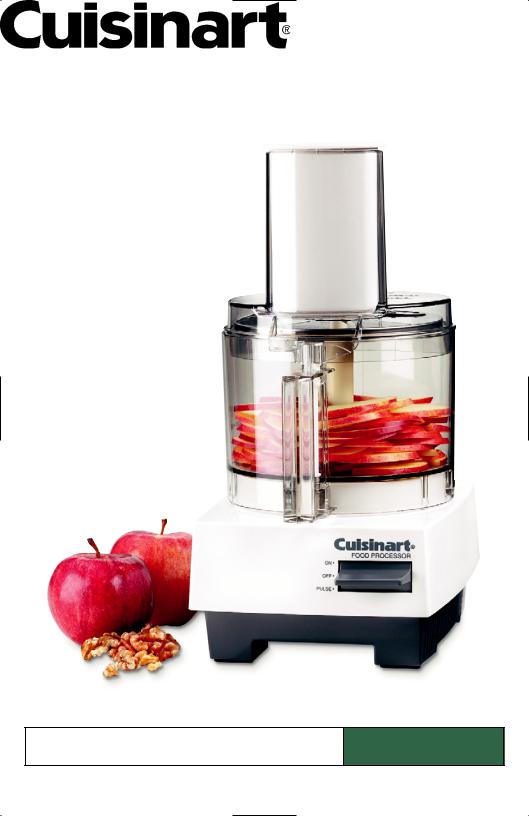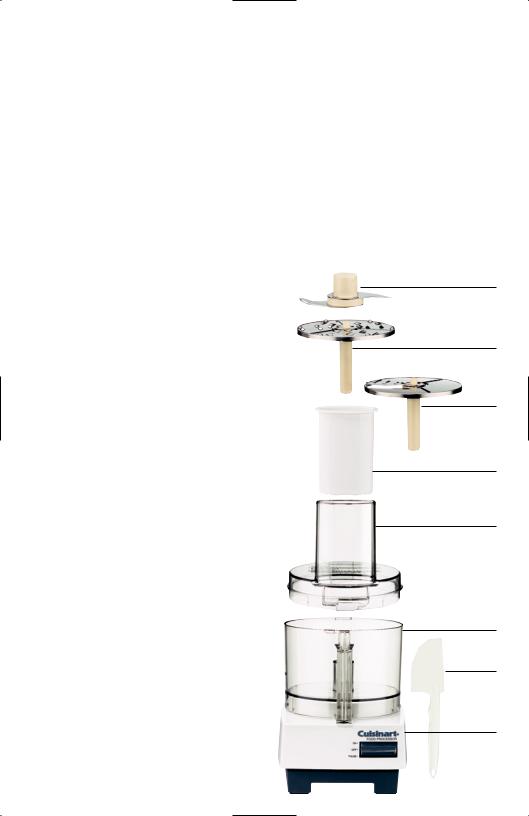Cuisinart DLC-5 User Manual

INSTRUCTION
AND RECIPE BOOKLET
FOOD PROCESSOR |
DLC-5 Series |
For your safety and continued enjoyment of this product, always read the instruction book carefully before using.

IMPORTANT UNPACKING INSTRUCTIONS
This package contains a Cuisinart® Food Processor and the standard parts for it:
Stainless steel chopping blade, slicing disc, shredding disc, spatula and instruction/recipe book.
CAUTION:
THE CUTTING TOOLS HAVE VERY SHARP EDGES. To avoid injury when unpacking the parts, please follow these instructions.
1.Place the box on a low table or on the kitchen counter where you plan to keep the food processor. Be sure that the box is right side up.
2.Remove the cardboard panel and the instruction material.
NOTE: Remember to return your warranty card with all information carefully filled out completely.
3.You will see a rectangular block of plastic foam that holds the processor parts, each fitted into a cavity in the foam.
•The plastic spatula (A) is in one long side of the foam block. Remove it first.
•The slicing disc (B) is on one side and the shredding disc (C) on the other.
•Slide them out of their grooves WITH GREAT CARE; THE BLADES ARE SHARP.
•The work bowl cover (D) and the pusher assembly (E) are in the center of the foam block. Grasp an edge of the work bowl and lift it straight up.
4.Lift out the plastic foam block.
5.The machine base and work bowl with metal blade are at the bottom of the box. CAREFULLY REMOVE THE METAL BLADE BY GRASPING THE CENTER HUB AND LIFTING IT STRAIGHT UP. NEVER TOUCH THE BLADES, WHICH ARE RAZOR SHARP.
6.Remove the base and bowl together by grasping the plastic bowl at the top with both hands and lifting the bowl straight up.
Do not rotate the bowl clockwise on the base. This will cause the bowl to separate from the base.
7.Place the food processor on a counter or table and read the instructions thoroughly before using the machine.
8.Save the carton that your food processor was packed in, and the carton inserts too. You will find them very useful if you need to repack the processor for moving or other shipment.
NOTE: Remember to return your completed warranty card with all information carefully filled out.
WHEN REMOVING
THE BLADE:
CAREFULLY REMOVE THE METAL BLADE BY GRASPING THE CENTER WHITE HUB AND LIFTING IT STRAIGHT UP. NEVER TOUCH THE BLADES, AS THEY ARE RAZOR SHARP
1

TABLE OF CONTENTS:
Introduction . . . . . . . . . . . . . . . |
. . . . . page 3 |
The Machine Includes . . . . . . . |
. . . . . page 3 |
Assembly Instructions . . . . . . |
. . . . . page 4 |
Operating Controls . . . . . . . . . |
. . . . . page 4 |
Practicing with Food . . . . . . . . |
. . . . . page 5 |
Adding Food While Processing |
. . . . page 5 |
Removing Processed Food . . . |
. . . . . page 5 |
Techniques for Chopping and |
|
Puréeing with the Metal Blade |
. . . . . page 5 |
Chop raw fruits and vegetables |
. . . . page 5 |
Purée fruits and |
|
cooked vegetables . . . . . . . . |
. . . . . page 5 |
Dislodge food . . . . . . . . . . . . . |
. . . . . page 6 |
Chop hard foods . . . . . . . . . . |
. . . . . page 6 |
Chop parsley and other foods |
. . . . . page 6 |
Chop peel from citrus fruit . . . |
. . . . . page 6 |
Chop sticky fruit like dates . . . |
. . . . . page 6 |
Chop meat, poultry, fish |
|
and seafood . . . . . . . . . . . . . |
. . . . . page 6 |
Purée meat, poultry, fish |
|
and seafood . . . . . . . . . . . . . |
. . . . . page 6 |
Chop nuts . . . . . . . . . . . . . . . |
. . . . . page 6 |
Make peanut butter . . . . . . . . |
. . . . . page 7 |
Make flavored butters . . . . . . |
. . . . . page 7 |
Make mayonnaise . . . . . . . . . . |
. . . . . page 7 |
Beat egg whites . . . . . . . . . . . |
. . . . . page 7 |
Whip cream . . . . . . . . . . . . . . |
. . . . . page 7 |
Make crumbs and crumb crust |
. . . . . page 7 |
Make pastry . . . . . . . . . . . . . . |
. . . . . page 7 |
Make quick breads and cakes |
. . . . . page 8 |
Preparing Food for Slicing |
|
and Shredding . . . . . . . . . . . . . |
. . . . . page 8 |
Round fruits and vegetables . . |
. . . . . page 8 |
Whole peppers . . . . . . . . . . . . |
. . . . . page 8 |
Large fruits . . . . . . . . . . . . . . . |
. . . . . page 8 |
Cabbage and iceberg lettuce . |
. . . . . page 8 |
Packing the feed tube . . . . . . . |
. . . . . page 8 |
Practicing Slicing and Shredding |
. . page 9 |
Removing Sliced or |
|
Shredded Food . . . . . . . . . . . . . . . |
. . page 9 |
Techniques for Slicing |
|
and Shredding . . . . . . . . . . . . . . . . |
. . page 9 |
Small round fruits |
|
and vegetables . . . . . . . . . . . . . . |
. . page 9 |
Long fruits and vegetables . . . . . . |
. . page 9 |
Small amounts of food . . . . . . . . . |
. . page 9 |
French-cut green beans . . . . . . . . |
. . page 9 |
Matchsticks or julienned strips . . . |
. . page 9 |
Slicing Meat and Poultry . . . . . . . . |
. page 10 |
Cooked meat and poultry . . . . . . . |
. page 10 |
Uncooked meat and poultry . . . . . |
. page 10 |
Sausages . . . . . . . . . . . . . . . . . . . |
. page 10 |
Firm cheeses . . . . . . . . . . . . . . . . |
. page 10 |
Slicing and Shredding Cheese . . . |
. page 10 |
Troubleshooting Guide . . . . . . . . . |
. page 11 |
Cleaning and Storing . . . . . . . . . . . |
. page 11 |
Safety . . . . . . . . . . . . . . . . . . . . . . . |
. page 12 |
Technical Data . . . . . . . . . . . . . . . . |
. page 12 |
Repacking for Shipment . . . . . . . . |
. page 12 |
Warranty . . . . . . . . . . . . . . . . . . . . |
. page 13 |
Recipes . . . . . . . . . . . . . . . . . . . . . |
. page 14 |
IMPORTANT
SAFEGUARDS
Always follow these safety precautions when using this appliance.
Getting Ready
1.Read all instructions.
2.Blades are sharp. Handle them carefully.
3.Always unplug from outlet when not in use, before putting on or taking off parts, before removing food and before cleaning. To unplug, grasp plug and pull from electrical outlet. Never pull cord.
4.Do not use outdoors.
5.Do not let cord hang over edge of table or counter, or touch hot surfaces.
6.Do not operate any appliance with damaged cord or plug, or after appliance has been dropped or damaged in any way. Return appliance to nearest authorized service facility for examination, repair, or electrical or mechanical adjustment.
Operation
1.Keep hands as well as spatulas and other utensils away from moving blades or discs while processing food, to prevent the possibility of severe personal injury or damage to food processor. A plastic scraper may be used, but only when the food processor motor is stopped.
2.Avoid contact with moving parts. Never push food down by hand when slicing or shredding. Always use pusher.
3.Make sure motor has completely stopped before removing cover. (If machine does not stop within 4 seconds after you remove the pusher assembly, call 1-800-762-0190 for assistance. Do not use machine.)
4.Never store any blade or disc on motor shaft. To reduce the risk of injury, no blade or disc should be placed on the shaft except when the bowl is properly locked in place and the processor in use. Store blades and discs as you would sharp knives, out of reach of children.
5.Be sure cover and feed tube are securely locked in place before operating food processor.
6.Never try to override or tamper with cover interlock mechanism.
Cleaning
To protect against risk of electrical shock, do not put base in water or other liquid.
2

General
1.Close supervision is necessary when any appliance is used by or near children.
2.Do not operate this, or any other motordriven appliance, while under the influence of alcohol or other substances that affect your reaction time or perception.
3.This food processor is UL listed for household use. Use it only for food preparation as described in this instruction/recipe book.
4.The use of attachments not recommended or sold by Cuisinart may cause fire, electrical shock or personal injury, or damage to your food processor.
5.To avoid possible malfunction of work bowl switch, never store processor with pusher assembly in locked position.
THE MACHINE INCLUDES
1.Housing base with motor shaft and 3-position control switch
2.Pusher that fits into feed tube and guides food for slicing or shredding
3.Cover with feed tube
4.7-cup work bowl
5.Stainless steel chopping/mixing blade for raw and cooked food to any consistency from coarse chop to fine purée
6.Slicing disc for perfect slices
7.Shredding disc for shredding vegetables, cheese, nuts and chocolate
8.Plastic Spatula
SAVE THESE INSTRUCTIONS
FOR HOUSEHOLD USE ONLY
NOTICE
This appliance has a polarized plug (one blade is wider than the other). As a safety feature, this plug will fit only one way in a polarized outlet. If the plug does not fit fully in the outlet, reverse the plug. If it still does not fit, contact a qualified electrician. Do not attempt to defeat this safety feature.
INTRODUCTION
Congratulations on your purchase of a Cuisinart® Food Processor. This product is the ultimate food preparation tool, and it comes from the originator of the America food processor, Cuisinart.
This Cuisinart® Food Processor has all the elements of quality that Cuisinart is known for, including a powerful motor that is strong
enough to knead bread dough, and a patented stainless steel chopping/mixing blade for tough jobs like chopping meat or delicate
jobs like chopping parsley. Also included are patented stainless steel shredding and slicing discs for perfect slices and shreds every time.
With your Cuisinart® Food Processor you will prepare meals that combine simplicity, speed, quality, taste and good nutrition. We’re confident that your Cuisinart® Food Processor will add to your pleasure in cooking for many years to come.
Chopping/Mixing
Blade
Medium Shredding
Disc With Stem
4mm Slicing Disc With Stem
Pusher
Cover with
Feed Tube
7-cup Work Bowl
Spatula
Housing
Base
3

ASSEMBLY
INSTRUCTIONS
Read all instructions before you start. Check that your household voltage matches that shown on label on bottom of food processor base.
Blade Operation
1.Put base on counter or table near electrical outlet. Do not plug in until food processor is totally assembled. Pick up empty work bowl, holding it in both hands, with handle toward you. Put bowl on base, fitting center tube over shaft on base and placing handle slightly to left of front center (7 o’clock).
2.Turn bowl counterclockwise as far as it will go. It will click into locked position.
3.Pick up metal blade by center plastic part. Never touch metal cutting blades, which are razor sharp. Note D-shaped outline on top; it matches shape of motor shaft.
4.Place blade over motor shaft, lining up D-shaped outline with shape of shaft. Blade should drop onto shaft. If it doesn’t, twist it gently clockwise until it does. Push top of center plastic part to push blade down as far as it will go. Lower blade should almost touch bottom of bowl.
5.Put cover on bowl, with feed tube at front, slightly to left of front center.
6.Turn cover counterclockwise to lock it into place. It will click into position. Motor will not start unless work bowl is securely locked in position and cover is securely locked on work bowl.
7.Insert pusher in feed tube. Always use pusher to guide food through feed tube. Never use your fingers or spatula.
8.Plug your Cuisinart® Food Processor into a household electrical outlet.
Disc Operation
1.Assemble bowl on base in usual way (see steps 1 and 2 above.)
2.Always handle slicing or shredding disc by rims. Never touch sharp cutting blades. Note D-shaped cutout on top of disc. It matches shape of motor shaft.
Place disc over motor shaft, lining up D-shaped cutout over shaft. Disc will drop onto shaft.
3.Be sure disc is pushed down as far as it will go. Push only on rim; never touch sharp cutting blade.
4.Put cover on work bowl and turn it counterclockwise to lock it into place.
5.Put food into feed tube. (If you are slicing, first cut one end of food flat.)
6.Insert pusher. Use moderate pressure to push down on pusher with one hand while holding control switch down with other hand until food is sliced or shredded. This will take only a few seconds.
Never put fingers or spatula in feed tube. Always use pusher.
Wait until disc stops spinning before removing cover. When it stops, remove cover before removing work bowl. Never try to remove cover and work bowl together; this could damage work bowl.
Remove disc before removing work bowl. Place two fingers under each side of disc and lift it straight up.
Then turn bowl clockwise to remove it from base and lift it straight up.
OPERATING CONTROLS
Control switch on base of machine has 3 positions, giving you fingertip control of operation.
For continuous operation, move control switch up to ON position. Motor will start.
To turn motor off, move control switch down to OFF position in center.
For on-off operation, called pulse-chopping or pulsing, press control switch down to PULSE position, then release it.
Motor runs as long as you hold control switch down. Motor stops when you release control switch. Try it a few times.
Notice that you control duration and frequency of pulses by length of time you hold control switch down and rate at which you press it. Allow enough time between pulses to let everything in work bowl fall to bottom.
Always use control switch for pulse/chopping. Never turn cover back and forth to start and stop processor.
4

PRACTICING WITH FOOD
Try chopping some food to get a feel of how the processor works. (You might start out with a soft fruit or vegetable like an onion or a zucchini.)
First, cut it into 1-inch (2.5cm) pieces.
Insert metal blade in work bowl and put in food pieces. Put on cover and lock it. Press control switch down to PULSE, then release it. Repeat two or three times. Each time blade stops, let food pieces drop to bottom of bowl before pulsing again. That puts them in path of blade when motor starts.
Watch what happens to food. (New users are often surprised at how fast the processor works. You will quickly get used to the speed.)
With pulse-chopping technique, you can get an even chop without danger of overprocessing. Check texture by looking through work bowl.
For a coarse chop, pulse only a few times.
For a finer chop, continue pulse/chopping until texture is the consistency you want.
Onions and other food with a high water content turn into a smooth purée very quickly. Do not over chop – look at food through work bowl after each pulse.
These are some conditions that affect results:
•Size of pieces you put in bowl – all should be about the same.
•Amount of food you process – don’t add too much at once.
•Type of processing you choose – continuous or pulse/chopping.
ADDING FOOD WHILE PROCESSING
When you want to add liquid while machine is running, pour it through open feed tube. This is especially useful when making mayonnaise, bread dough, cakes and many other recipes. See Index for recipes.
When you want to add small pieces of food like cheese, meat or garlic cloves while machine is running, drop them through open feed tube.
REMOVING
PROCESSED FOOD
Before removing processed food, wait for blade to stop spinning. Then remove cover by turning it clockwise. Never try to remove cover and work bowl together; this can damage work bowl.
After processing liquids, remove work bowl from base of processor before removing metal blade. Turn handle of bowl clockwise to unlock bowl from base and lift bowl straight up.
It is important not to let blade fall out of work bowl when you empty it. Here are three ways to prevent this:
1.Before tilting bowl, use spatula to remove food from around blade. Carefully remove blade by finger grips on each side of center plastic knob.
2.Hold top of blade in place with finger or spatula while pouring out processed food.
3.Make sure your hands are dry. Insert finger through hole in underside of bowl and place thumb on rim of bowl. Grip inside of blade shaft firmly to hold blade in place.
TECHNIQUES FOR CHOPPING AND PURÉEING WITH THE METAL BLADE
To chop raw fruits and vegetables:
First cut the food into 1-inch (2.5cm) pieces. You get a more even chop when all pieces are about the same size.
Put no more than the recommended amount of food into the work bowl (see table inside front cover). Lock the cover in place. Press the PULSE button at the rate of 1 second on,
1 second off, until the food is coarsely chopped. For more finely chopped results, hold the PULSE button, letting the machine run continuously until the desired consistency is reached. Check frequently to avoid overprocessing. Use the spatula to scrape down the sides of the work bowl if necessary.
To purée fruits and cooked vegetables:
First, cut the food into 1-inch (2.5cm) pieces. You get a smoother purée faster when all pieces are about equal in size.
5

Put no more than the recommended amount of food in the work bowl (see table inside front cover). Lock the cover in place. PULSE to chop coarsely, then press the ON button and process continuously until food is puréed. (NOTE: Cooked potatoes are an exception to this procedure. They develop a gluey texture when processed with the metal blade.)
When making soup, you will want to purée vegetables that have been cooked in liquid. Don’t add the liquid to the work bowl, just the cooked vegetables; remove vegetables with a slotted spoon. They will purée faster and smoother without liquid. Then add just enough liquid to make the purée pourable, return to the soup liquid and stir to combine.
To dislodge food:
Occasionally, a piece of food may become wedged between the blade and the work bowl. If this happens, unplug the machine, remove the cover, lift the blade out carefully and remove the wedged piece. Empty the bowl, reinsert the blade and lock the cover into place. Press the ON button and drop the food pieces through the feed tube opening while the machine is running. After adding a cupful this way, add the remaining food to the bowl and process in the usual manner.
To chop hard foods:
To chop hard food like garlic and hard cheese, assemble the unit, remove the pusher, press the ON button and drop the food through the feed tube while the machine is running.
Small foods like garlic can be dropped in whole. Large foods like hard cheese should be cut into 1-inch (2.5cm) pieces. This method of processing minces garlic, shallots and onions. Hard cheese and coconut will have the same texture as if they had been hand grated.
IMPORTANT: Never try to process cheese that is too hard to cut with a knife. You may damage the blade or the machine.
To chop parsley and other fresh herbs:
The herbs, the work bowl and the metal chopping blade must all be thoroughly clean and dry. Remove stems from herbs. Add leaves to bowl and process, using the PULSE button until chopped as fine as desired. The more herbs you chop at a time, the finer chop you can obtain. If completely dry when chopped, parsley and other herbs will keep for at least 4-5 days, stored in an airtight bag in the refrigerator. They may be frozen for months, stored in an airtight container or bag.
To chop peel from citrus fruit or to chop sticky fruit like dates or raisins:
For citrus, remove only the peel with a vegetable peeler, not the white pith which is bitter tasting.
Cut the peel into lengths of 2 inches (5cm) or less and process with 1/2 cup (125 ml) of
granulated sugar until finely chopped. This may take 2 minutes or longer.
For sticky fruit like dates, raisins, prunes and candied fruit, first freeze the fruit for about 10 minutes. Add some of the flour called for in the recipe to the fruit. Use no more than 1 cup (250 ml) of flour for each cup of fruit.
To chop meat, poultry, fish and seafood:
The food should be very cold, but not frozen. Cut it into 1-inch (2.5cm) pieces to ensure an even chop. Using the ON button, process no more than the recommended amount at one time (see table inside front cover). Press the PULSE button 3 or 4 times at a rate of
1 second on, 1 second off. If the food is not chopped finely enough, let the processor run continuously for a few seconds. Check the texture often to avoid overprocessing. Use
a spatula to scrape food from the sides of the bowl as necessary.
To purée meat, poultry, fish and seafood:
Prepare the food as described above. Press the PULSE button until evenly chopped, then process continuously to the desired texture. Scrape the bowl with a spatula as needed.
Leave the purée in the work bowl and add eggs, cream and seasonings as called for by the recipe. Process to combine thoroughly.
Remember, you control texture by the length of time you process. By varying the processing time, you can get a range of textures suitable for hamburgers, hash, stuffed peppers, or smooth mousses.
To chop nuts:
Chop no more than the recommended amount at one time. Press and release the PULSE button and check frequently to avoid nuts clumping together in a nut butter. When a recipe calls for flour or sugar, add some to the nuts before you chop, about 1/2 cup for each cup of nuts. This allows you to chop the nuts as fine as you want without turning them into a nut butter. You can also chop nuts with a shredding or slicing disc. The optional Fine Shredding Disc is particularly good.
6

To make peanut butter and other nut butters:
Process up to the recommended amount of nuts. Using the ON button, let the machine run continuously.
After 1-1/2 to 2 minutes, the ground nuts will form a ball that will gradually smooth out. Scrape the sides of the bowl and continue processing until drops of oil are visible. Taste for consistency. The longer you process, the softer the butter. For chunk style, add a handful of nuts just after the ball of nut butter begins to smooth out. To make cashew butter, add a little bland vegetable oil. Processor nut butters contain no preservatives. Store in refrigerator to keep from separating.
To make flavored butters, spreads and dips:
Cut room temperature butter into tablespoon size pieces. Finely chop flavoring ingredients first, such as anchovies, cheese, herbs, etc. Be sure work bowl is clean and dry. Add small hard ingredients like garlic and hard cheese through the feed tube while machine is running. Next, add the butter and process using the ON button, until smooth.
Add any liquid ingredients last, while the processor is running, and process just long enough to blend. Process ingredients for spreads and dips the same way. They should be at room temperature and cut into 1-inch (2.5cm) cubes, or added by tablespoonfuls.
To make mayonnaise:
You can make foolproof homemade mayonnaise in your food processor. The work bowl and metal blade must be clean and dry. Use the metal blade to process eggs (for safe food procedures, we recommend using pasteurized liquid eggs, or the "cooked egg" recipe on page 21), salt, vinegar or lemon juice, dry mustard, and two tablespoons of the oil until smooth, at least 30 seconds. With the machine running, pour 1/4 cup of the oil into the pusher. After it dribbles through the pinhole in the bottom, remove the pusher and very slowly add the remaining oil while the machine runs. Process until all the oil has been added and the mixture is totally emulsified. Remove from the processor, cover and keep chilled until ready to use. Homemade mayonnaise will keep in the refrigerator for 3 to 4 days.
For a "one egg" batch of basic mayonnaise, use 1/4 cup of liquid pasteurized eggs,
2 tablespoons vinegar or lemon juice,
1 teaspoon dry mustard, 1/2 teaspoon kosher salt and 1 cup vegetable oil, such as canola oil. For variation, you may experiment with using
flavored vinegars, or adding chopped fresh herbs, or even roasted garlic to taste. To make your mayonnaise a little lighter, you may add some well-drained nonfat plain yogurt to taste.
To beat egg whites:
The work bowl must be absolutely clean. Add 3 or more egg whites (up to 6 large egg whites) and press the ON button. Add about 1 teaspoon of lemon juice or vinegar for every egg white. Vinegar makes stiffer whites; its flavor is hardly detectable in cakes or soufflés. Continue processing until the egg whites hold their shape, about 1-1/2 to 2-1/2 minutes.
To whip cream:
Processor whipped cream holds its shape very well. It is good for decoration or as a topping; however, it will not whip to the light, fluffy consistency obtained by methods that beat in more air. Chill the cream well before starting. Process continuously using the ON button, until it begins to thicken. Then add sugar as desired and continue processing, watching carefully for the desired consistency.
For consistently reliable results, add 2 tablespoons (30 ml) of nonfat dry milk for every cup of cream before whipping.
To make crumbs and crumb crusts:
Cut or break bread, crackers or cookies into 1-inch pieces and place in work bowl. Press the ON button and process continuously until they reach the desired texture. For seasoned crumbs, chop parsley or other fresh herbs with the crumbs. For buttered crumbs, process until the dry crumbs are of the desired texture, then dribble melted butter through the feed tube opening while the machine is running. For crumb crusts, process crackers or cookies as described above. Add sugar, spices and butter, and cut into pieces as specified by your recipe. Process until well combined.
To make pastry:
Combine unbleached all-purpose flour, salt and pieces of very cold butter in the work bowl. Process to the consistency of cornmeal. Sprinkle evenly with the minimum amount of cold liquid in the recipe. PULSE 5 or 6 times. The dough should begin to hold together when pressed. If it is still dry and crumbly, add more water – 1 teaspoon at a time – until the dough holds together easily. Do not let the dough form a ball in the processor or it will be overworked and tough. Form into a round disc, one inch thick, and wrap in plastic wrap. Refrigerate for 1 hour before using, or doublewrap and freeze for later use.
7

To make quick breads and cakes that use baking powder and/or soda:
The most important rule for success is not
to overmix after adding dry ingredients to wet ingredients. The ingredients for these soft doughs should be cold, except butter. If the recipe calls for chopped ingredients like lemon peel or nuts, chop them first while the work bowl is clean and dry, then set aside until needed.
Put dry ingredients like flour, salt and leavening in the work bowl and process with the metal blade for 5 seconds to mix.
Remove and reserve the dry ingredients.
Add the eggs and sugar to the work bowl and, using the ON button, process to mix, letting the machine run about 1 minute. Next, add butter at room temperature and cut into 1-inch pieces. Run machine continuously for a minute, until the butter is thoroughly mixed with the sugar and eggs. Then add flavoring and liquid – vanilla, spices, cocoa, etc. Process until mixed. Add the dry ingredients to the work bowl.
Process by pulsing, inspecting after each pulse. Stop pulsing as soon as the dry ingredients have almost disappeared into the batter. Overprocessing will cause quick breads and cakes to be tough. (If your recipe calls for ingredients that are to be coarsely chopped – like raisins or nuts – add them last with the mixed dry ingredients.)
To make cake mix:
Your food processor work bowl is large enough for the preparation of an 18.5-ounce packaged cake mix.
Insert the metal blade and add the cake mix to the work bowl. Press the ON button and while the machine is running, add the eggs and liquid through the feed tube and process for 5 seconds.
Scrape down the sides of the work bowl and process 1 minute more for maximum volume. Do not remove the metal blade.
Insert a finger into the underside of the blade from the bottom of the work bowl to hold the blade in place while emptying the batter.
Tip:
After emptying cake batter or puréed soup from the work bowl, replace the bowl on the motor base and PULSE once. Centrifugal force will spin the batter off the blade onto the sides of the work bowl. Remove the blade, and use the spatula to scrape any remaining batter from the bowl.
PREPARING FOOD FOR SLICING AND SHREDDING
For disc assembly instructions, refer to Assembly Instructions.
Round fruits and vegetables:
Before processing onions, apples and other large, round fruits and vegetables, cut the bottom ends flat to make the food sit stable on the disc.
Place the food in the feed tube, flat side down, as far left as possible, to prevent it from tilting when being processed.
Choose fruits that are firm and not too ripe. Remove large hard pits and seeds from fruits before processing. Seeds from citrus fruits need not be removed. Remove the rind or peel before slicing or shredding, if desired.
Whole peppers are an exception:
Remove the stem and cut the stem end flat. Remove the core and scoop out the seeds. Leave the end opposite the stem whole, to keep the structure stiff. This ensures round, even slices.
Large fruits like pineapple:
Cut the ends flat, cut in half, and either core or remove the seeds. If necessary, cut the halves into smaller pieces to fit the feed tube.
Cabbage and iceberg lettuce:
Turn the head on its side and slice off the top and bottom, leaving a center section about 3 inches (8cm) deep. Remove the core, then cut in wedges to fit the feed tube. Remove the core from the bottom and top pieces and cut into wedges to fit into the feed tube.
The optional 2mm Slicing Disc is excellent for slicing cabbage for coleslaw.
If the fruit or vegetable doesn’t fit, try inserting it from the bottom of the feed tube, where the opening is slightly larger.
Pack the feed tube for desired results:
For long slices or shreds, cut food to the width of feed tube and pack pieces horizontally.
For small, round slices or short shreds from carrots, zucchini and other long vegetables, cut to height of feed tube and pack tightly upright.
Food should fit snugly, but not so tightly that it prevents the pusher from moving.
When slicing or shredding, always use the pusher.
8
